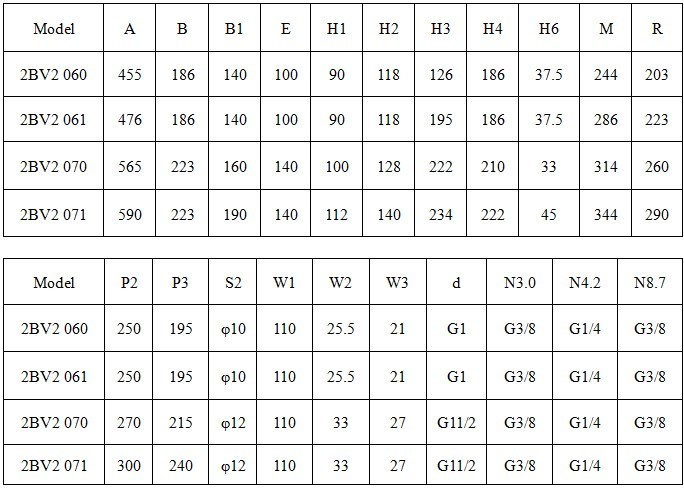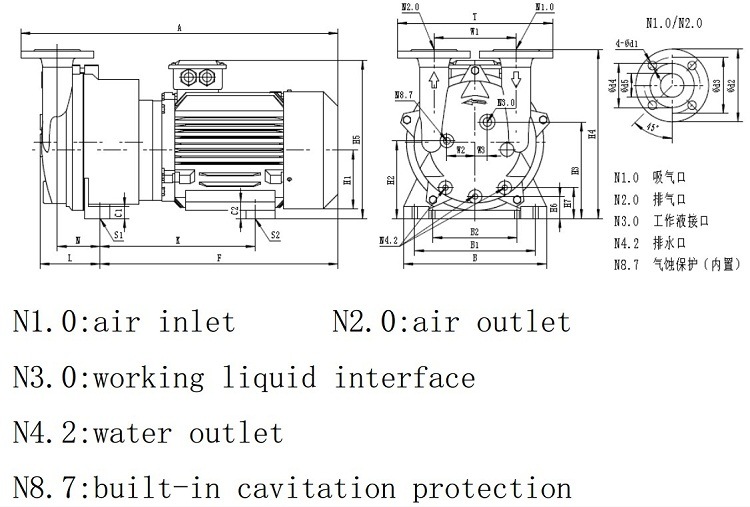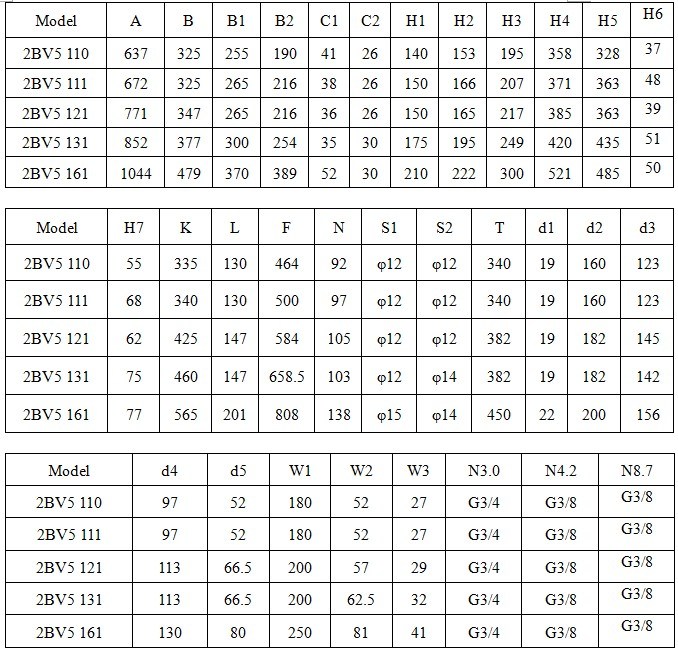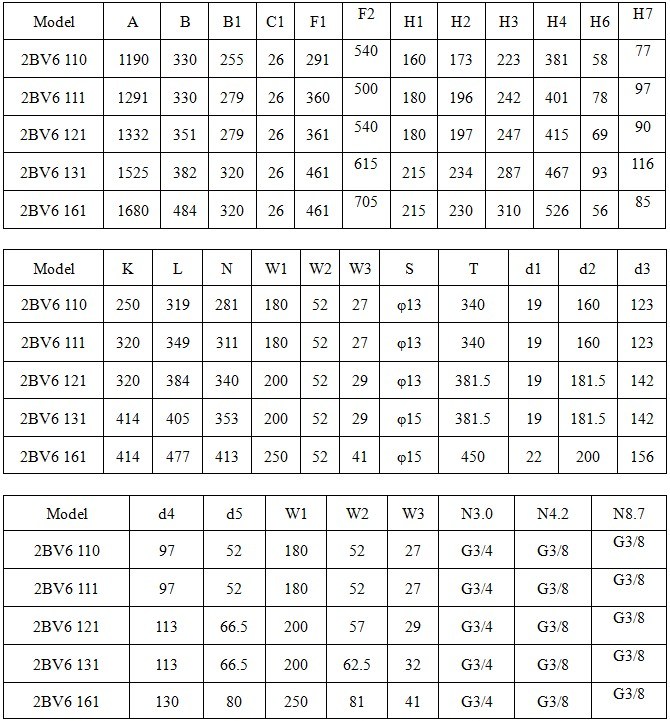2BV2 060 Liquid/Water Ring Vacuum Pump for Autoclave Sterilizer
2BV2 060 liquid/water ring vacuum pump for autoclave sterilizer
Product Description
2BV series vacuum pump has small volume, compact structure, directly connected motor, while installation, put it in horizontal plane, no need chassis.
2BV series vacuum pump works basing on water ring principle, that is, impeller is installed eccentrically inside of pump body, after the pump start up, working liquid forms liquid ring(which is concentric with pump body ) inside of pump body, impeller passes motor power to liquid ring. Liquid ring pulse periodically between the impeller vanes, while in pulsation, gas is suctioned in through disk suction inlet and discharged from disk exhaust vent.
Pump Specifications:
| Model | Power (kw) | Max Vacuum | Capacity (m³/min) | Weight (kg) |
| 2BV2 060 | 0.81 | -0.095Mpa | 0.45 | 31 |
| 2BV2 061 | 1.45 | 0.86 | 35 | |
| 2BV2 070 | 2.35 | 1.33 | 56 | |
| 2BV2 071 | 3.85 | 1.83 | 65 | |
| 2BV2 060-Ex | 1.1 | 0.45 | 39 | |
| 2BV2 061-Ex | 1.5 | 0.86 | 45 | |
| 2BV2 070-Ex | 3 | 1.33 | 66 | |
| 2BV2 071-Ex | 4 | 1.83 | 77 | |
| 2BV5 110 | 4 | 2.75 | 103 | |
| 2BV5 111 | 5.5 | 3.83 | 117 | |
| 2BV5 121 | 7.5 | 4.66 | 149 | |
2BV5 131 |
11 | 6.66 | 205 | |
| 2BV5 161 | 15 | 8.33 | 331 | |
| 2BV6 110 | 4 | 2.75 | 153 | |
| 2BV6 111 | 5.5 | 3.83 | 208 | |
| 2BV6 121 | 7.5 | 4.66 | 240 | |
| 2BV6 131 | 11 | 6.66 | 320 | |
| 2BV6 161 | 15 | 8.33 | 446 |
Product Details
2BV2 series outline dimensional drawing:


Â
2BV5 series outline dimensional drawing:


2BV6 series outline dimensional drawing:


Packaging:
Standard export polywooden cases.
Customized packaging can be available.
Shipping:
| Shipping method | Note |
| Express | Door to door, very convenient, don't need customs clearance or pick-up. |
| By air | Airport to airport, you need to do the customs clearance and pick up the goods at your local airport. |
| By sea | Port to port and you need to do the customs clearance and pick-up the goods at your local port. |
Our Services
Pre-Sales Service
Provide 24-hour reply.
Provide suitable models according to clients' requirements.
Provide detailed product specifications and reasonal prices.Â
In-Sales Service
Supervise whole production time.Â
Provide product's testing performance curve to customers.
Provide inspection pictures to customers after we finish production.
After-Sales Service
Provide installation manual.
Under correct installation, normal maintenance and using,we guarantee one-year warranty.
If product has malfunction,we'll reply you within 24 hour and provide solution or even send technical staff to spot after receiving maintenance notification.
FAQ
1.  Q: Are you a manufacturer or trading company?
  A: We are manufacturer of vacuum pumps and water pumps in China since 1986.
2.  Q: What's your MOQ?
    A: One set is ok.
3.  Q: What's your payments terms?
    A: T/T, Western Union......
4.  Q: What certificates do you have?
    A: CE, ISO 9001 ....
5.  Q: How about the warranty?
    A: 12 months warranty since delivery.
6.  Q: What's the delivery time?
    A: For different models,different motor specs and different material,delivery time is different,please double confirm with our sales team.
7.  Q: Can you do OEM brand?
    A: Yes, welcome.
8.  Q: Quality reliable?
    A: We have whole testing system controlled by micro-machine,testing performance curve can be sent to clients before arrange delivery.
2BV2 060 liquid/water ring vacuum pump for autoclave sterilizer
Product Description
2BV series vacuum pump has small volume, compact structure, directly connected motor, while installation, put it in horizontal plane, no need chassis.
2BV series vacuum pump works basing on water ring principle, that is, impeller is installed eccentrically inside of pump body, after the pump start up, working liquid forms liquid ring(which is concentric with pump body ) inside of pump body, impeller passes motor power to liquid ring. Liquid ring pulse periodically between the impeller vanes, while in pulsation, gas is suctioned in through disk suction inlet and discharged from disk exhaust vent.
Pump Specifications:
| Model | Power (kw) | Max Vacuum | Capacity (m³/min) | Weight (kg) |
| 2BV2 060 | 0.81 | -0.095Mpa | 0.45 | 31 |
| 2BV2 061 | 1.45 | 0.86 | 35 | |
| 2BV2 070 | 2.35 | 1.33 | 56 | |
| 2BV2 071 | 3.85 | 1.83 | 65 | |
| 2BV2 060-Ex | 1.1 | 0.45 | 39 | |
| 2BV2 061-Ex | 1.5 | 0.86 | 45 | |
| 2BV2 070-Ex | 3 | 1.33 | 66 | |
| 2BV2 071-Ex | 4 | 1.83 | 77 | |
| 2BV5 110 | 4 | 2.75 | 103 | |
| 2BV5 111 | 5.5 | 3.83 | 117 | |
| 2BV5 121 | 7.5 | 4.66 | 149 | |
2BV5 131 |
11 | 6.66 | 205 | |
| 2BV5 161 | 15 | 8.33 | 331 | |
| 2BV6 110 | 4 | 2.75 | 153 | |
| 2BV6 111 | 5.5 | 3.83 | 208 | |
| 2BV6 121 | 7.5 | 4.66 | 240 | |
| 2BV6 131 | 11 | 6.66 | 320 | |
| 2BV6 161 | 15 | 8.33 | 446 |
Product Details
2BV2 series outline dimensional drawing:


Â
2BV5 series outline dimensional drawing:


2BV6 series outline dimensional drawing:


Packaging:
Standard export polywooden cases.
Customized packaging can be available.
Shipping:
| Shipping method | Note |
| Express | Door to door, very convenient, don't need customs clearance or pick-up. |
| By air | Airport to airport, you need to do the customs clearance and pick up the goods at your local airport. |
| By sea | Port to port and you need to do the customs clearance and pick-up the goods at your local port. |
Our Services
Pre-Sales Service
Provide 24-hour reply.
Provide suitable models according to clients' requirements.
Provide detailed product specifications and reasonal prices.Â
In-Sales Service
Supervise whole production time.Â
Provide product's testing performance curve to customers.
Provide inspection pictures to customers after we finish production.
After-Sales Service
Provide installation manual.
Under correct installation, normal maintenance and using,we guarantee one-year warranty.
If product has malfunction,we'll reply you within 24 hour and provide solution or even send technical staff to spot after receiving maintenance notification.
FAQ
1.  Q: Are you a manufacturer or trading company?
  A: We are manufacturer of vacuum pumps and water pumps in China since 1986.
2.  Q: What's your MOQ?
    A: One set is ok.
3.  Q: What's your payments terms?
    A: T/T, Western Union......
4.  Q: What certificates do you have?
    A: CE, ISO 9001 ....
5.  Q: How about the warranty?
    A: 12 months warranty since delivery.
6.  Q: What's the delivery time?
    A: For different models,different motor specs and different material,delivery time is different,please double confirm with our sales team.
7.  Q: Can you do OEM brand?
    A: Yes, welcome.
8.  Q: Quality reliable?
    A: We have whole testing system controlled by micro-machine,testing performance curve can be sent to clients before arrange delivery.
TPR or thermoplastic rubber is typically a copolymer that merges the properties of polystyrene (PS) and butadiene (synthetic) rubber. This material was developed to provide much of the property benefit of synthetic rubber while allowing processing (and reprocessing) in the more precise and controllable injection molding process. TPR delivers outstanding fatigue resilience, chemical stability, impact strength, and moderate recyclability, with the right processing.
TPU or thermoplastic polyurethane is a wide classification of polyurethane polymers that share properties such as: elasticity, transparency, wear resilience, and very high resistance to oils. The materials are thermoplastic, with a range of degrees of elastomeric behavior. Their high strength and resilience are derived from a polymer chain structure consisting of alternating hard and soft segments.
This article will further compare TPR vs. TPU, their applications, uses, physical properties, and alternative materials.
What is TPR?
TPR (thermoplastic rubber) typically consists of a blending of 23% PS and 77% butadiene. It is prepared by emulsion polymerization of constituent polymers. The process makes an inseparable material that contains an elastomeric, thermoset phase, and a distributed, rigid matrix of thermoplastic material. The result derives properties from both components but is able to be processed with extreme precision in injection molding equipment. For more information, see our guide on What is Thermoplastic Rubber.
Typical rubbers are synthesized or refined in a partially polymerized form, and then heat is applied to finish the cross-linking process. In the case of TPR, the butadiene component is manufactured fully cross-linked and produced as a fine powder. The PS component then substitutes for the cross-linking by bonding the rubber into a strong polymer matrix. Flexibility results from the elasticity of the butadiene component, where the intra-particle rubber bonding is essentially inelastic.
TPR does not match the performance of vulcanized rubbers, so it is not suitable for tire manufacture, having too low a tear modulus. However, the significantly better ozone-, weathering-, and UV-resistant properties of TPR mean that it finds wide application across many product sectors.
What is TPU?
TPU polymers are made of block structures with longer, [soft" regions of low polarization, and short, [hard" sections of much higher polarization. Covalent linkages between the two segment types make well-integrated chains that derive properties from both chain elements. By altering the molecular weights and ratios of the constituent parts, a wide range of properties can be derived in chemically (almost) identical materials. The glass transition temperatures of the two components can be similar or disparate, and they can be chemically altered to be higher or lower. These processing issues allow the production of a range of thermal properties of the resulting material family.
The higher polarization of the harder elements induces strong attraction, which induces pseudo-crystalline regions, located in a highly elastic matrix. The pseudo-crystalline regions behave as cross-linking elements, which account for the high elastic modulus of the family, whereas the longer, softer chains moderate this effect, allowing a range of hardness/elasticity to be manufactured.
This cross-linking effect diminishes to zero as the glass transition temperature of the harder component is exceeded. The family behaves as a fully thermoplastic material group that can be processed in ordinary injection molding equipment. TPUs can be recycled by melting and reforming, although the degradation in chain length/integrity is significant on remelting.
TPR vs. TPU: Applications and Uses
Listed below are the typical industries and the common TPR applications:
Auto Manufacture: Door and window seals, transmission/suspension parts, fender inserts, exterior and interior trim, instrument panels, AC and engine air ducts, grommets, drive belts, fluid pipes, floor mats, O-rings.
Construction: Door and window seals, hydraulic seals, plumbing seals.
Industrial: Vibration dampers, pipes, manifolds, seals, suspension bushes, shock absorbers, roof membranes.
Consumer: Refrigerator seals, handgrip overmolds, mobile phone covers, switch panels, vibration dampers.
Medical: Air tubes, syringe seals, breathing masks and plenums, seals, valves, and catheters.
Electronics: Encapsulation, power leads, high-quality cables, mobile phone shock protection, and seals.
Footwear & Sports Equipment: Diving flippers, snorkels, masks, ski-pole grips, ski-boot components, and shoe soles.
Listed below are the typical industries and the common TPU applications:
Automotive: Automotive interior parts (good surface finish, durability, wear resistance; and low cost).
Agriculture: ID tags for animals (great flexibility, tear and weather resistance, and temperature tolerance. Great for encapsulating RFID).
Piping and Plumbing: Seal profiles and O-rings, tubes, belts, and hoses. Specialist polymers with optimal melt-flow properties, extrusion-adapted high resistance to hydrolysis by hydraulic and other oils and organics, resistance to compression at high temperatures, high toughness, flexibility, and resistance to tearing.
Textile: Used for conveyor belts, inflatables, and military equipment. Wide range of processing options, and good mechanical, chemical, and thermal properties.
Sports Equipment: Extreme flexibility, high-impact and temperature resistance, transparency, and environmental tolerance.
There are common market sectors and ostensibly common product areas that can use either TPR or TPU materials. In general, the commonalities do not imply interchangeability, as each application tends to exploit a narrow property of one or another material. For example, the automotive sector tends to use TPRs for extreme flexibility and weathering properties, and TPUs for resilience, wear resistance, and ergonomic applications
TPR vs. TPU: Recyclability and Sustainability
Both materials are derived from petrochemical sources, and their sustainability and recycling credentials are quite similar. TPU is highly recyclable; its waste can be processed back into high-quality raw material. Although, it tends to be second-grade due to thermal decomposition. TPU is also biodegradable and will generally break down in landfill/compost conditions over 3–5 years. It leaves no toxic residues when it breaks down. TPUs are also slowly becoming available and can be manufactured from bio-sourced monomers.
TPR is also highly recyclable, but like most polymers, the recycled material is second-grade. They are stable materials that degrade extremely slowly in the natural environment. Algal-derived monomer source materials for TPRs are also becoming available.
TPR vs. TPU: Cost
TPRs are generally very low-cost materials, in the range of $1.60 to $2.00 per kg. TPUs are a little more expensive, at $2.00 to $4.00 per kg.
Alternative Materials to TPR and TPU
For injection molding use, a wide variety of thermoplastic elastomeric materials are available, with an equally wide spectrum of properties and costs. While these are not interchangeable across the whole range, there are many commonalities of properties that result in options at the specification stage. Listed below are some alternative materials:
Thermoplastic Vulcanisates (TPE-V or TPV).
Thermoplastic Polyolefins (TPE-O or TPO).
Thermoplastic Copolyesters (TPE-E, COPE, or TEEE).
Thermoplastic Polyether Block Amides (TPE-A).
Styrenic Block Copolymers (TPE-S).
Melt-Processable Rubber (MPR).
Fluoropolymer Elastomers (FPE).
When a switch to thermosetting polymers is an option, there are more material choices, as listed below:
Vulcanized natural rubber (NR) (latex, vulcanized to form Buna rubber).
Polyisoprene (IR).
Polychloroprene (CR).
Butadiene rubber (BR).
Nitrile (butadiene) rubber (NBR).
Thermoset rubbers bring new properties and new restrictions to the options list. They can, however, achieve remarkable results whenever specific properties are sought and the processing issues do not prevent use.

TPU Thermoplastic Polyurethane,Tpr Extrusion Profile,TPR, TPU string,Tpr Extruded Profile
Hony Engineering Plastics Limited , https://www.honyplastic.com